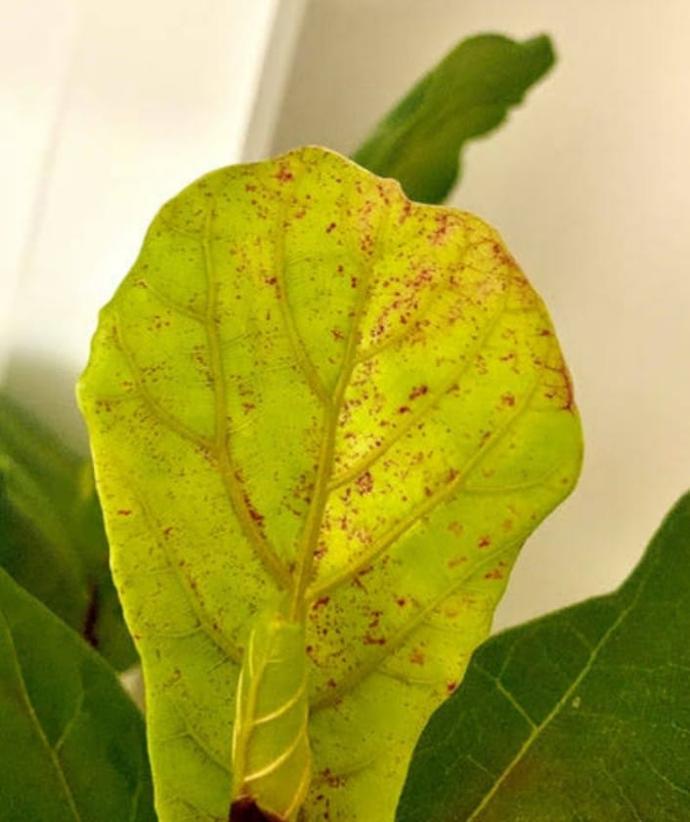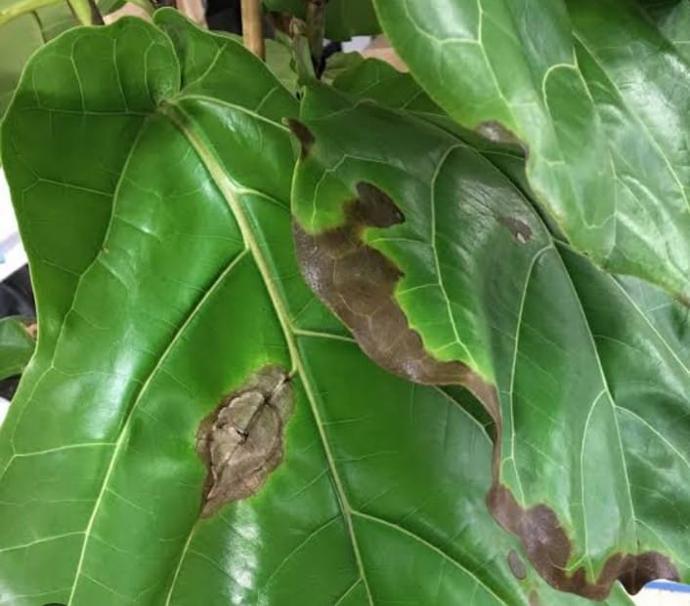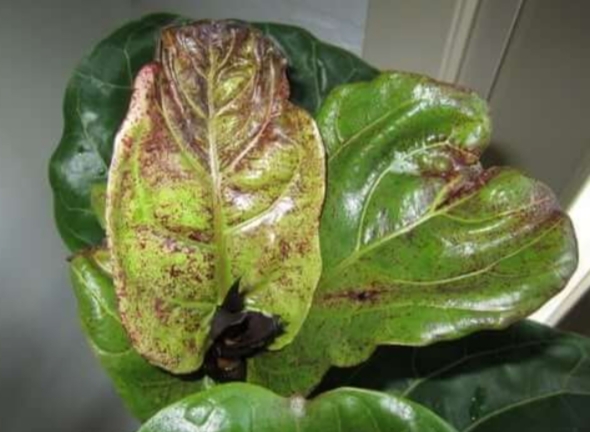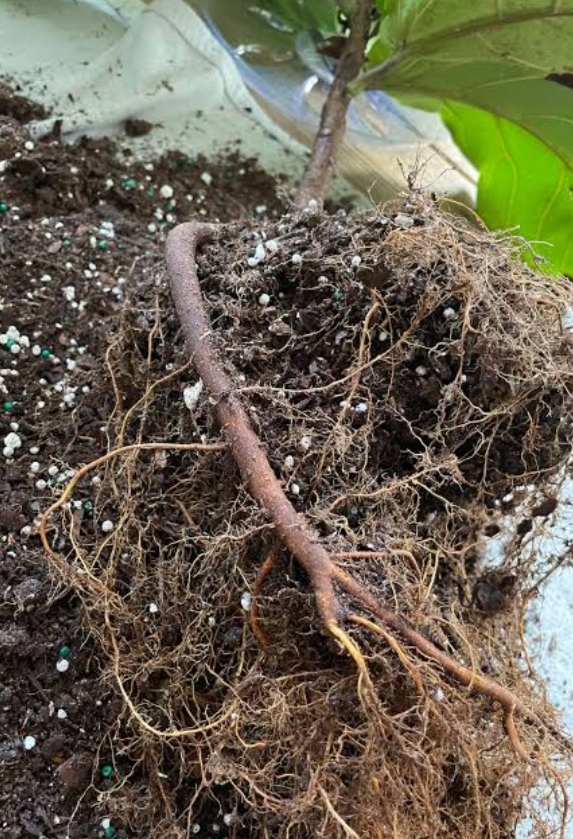Fiddle Leaf Fig Plant
Fiddle Leaf Fig, or Ficus lyrata, is an indoor tree with large, fiddle-shaped leaves. Plant in well-draining soil and provide bright, indirect light. Allow the soil to partially dry between waterings. Pruning helps control its size and remove any damaged leaves.
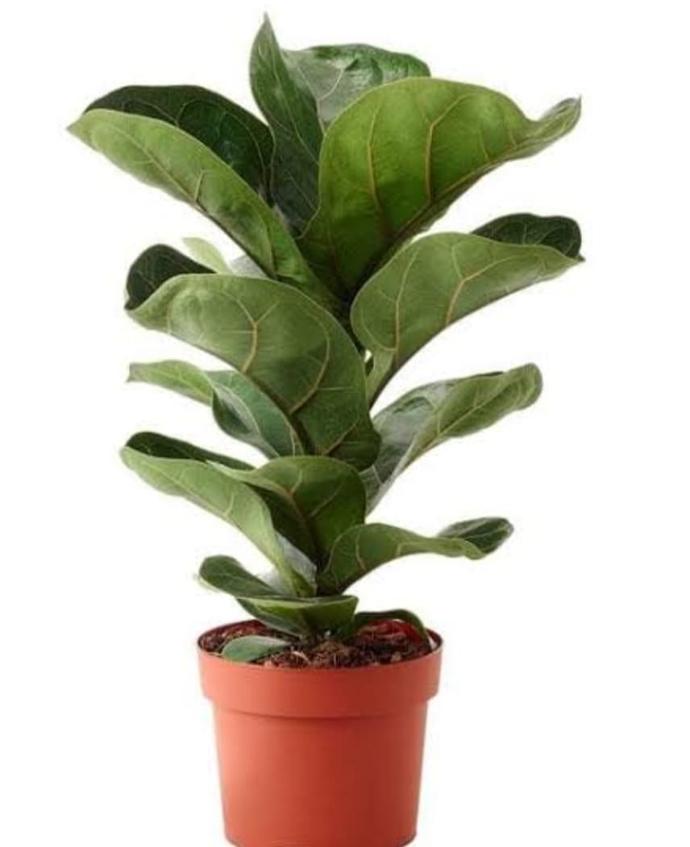
Habit
Tree
Height
1-3 m
Growth
Moderate
Soil
Well-drained, sandy loam
Shade
Indirect light to shade
Moisture
Moist
Edible
No
Medicinal
No
Origin
Western Africa
Climatic Condition
Tropical
Temperature (°)
20-30°C
Humidity (%)
50-70%
Potting media
Peat-based mix
Fertilizers
Organic compost
Watering
Water regularly; prefers moist soil
Plant Weight
2-3 kg
Flowering Time
Spring to Summer
Soil Ph level
6.0 - 7.5
Water Ph level
6.0 - 7.0
Soil EC
0.3 - 0.5
Yield Per Plant
Ornamental use
NPK ratio
10:10:10
life Span
Perennial
Health Benefits
Popular indoor plant; improves air quality.
Suggested Grow Media or Potting Mix ?
50% peat moss, 30% perlite, 20% compost
Suggested Fertigation/Fertilizers
Fertilize every 4 weeks with a balanced fertilizer.
Common Diseases and Remedies
Root rot, Leaf spot
Brown spots on leaves and dropping of older leaves.
Potting gravel to improve drainage. Avoid over watering.
HEALTH BENEFITS
The Fiddle Leaf Fig (Ficus lyrata) can have many health benefits, including:
- Improved air quality: Fiddle Leaf Figs remove toxins from the air and release oxygen.
- Improved mood: Being around plants can boost your mood and attract positive energy.
- Stress reduction: Caring for a Fiddle Leaf Fig can lower blood pressure and soothe the nervous system.
- Improved focus and concentration: Owning a houseplant can improve your ability to focus and concentrate.
- Improved sleep: The large leaves of the Fiddle Leaf Fig produce a large amount of oxygen during photosynthesis.
- Improved perception of room temperature: Fiddle Leaf Figs can improve your perception of room temperature.
- Increased humidity: Fiddle Leaf Figs increase relative humidity in your home.
- Noise reduction: The large leaves, stems, and branches of the plant absorb sound waves.
What Is A Fiddle Leaf Fig Plant?
A Fiddle Leaf Fig plant, scientifically known as Ficus lyrata, is a popular species of houseplant appreciated for its large, glossy, violin-shaped leaves. Native to western Africa, particularly regions of Cameroon, Liberia, and Sierra Leone, the Fiddle Leaf Fig has become a favorite choice for interior decorating due to its striking appearance and relatively low maintenance requirements.
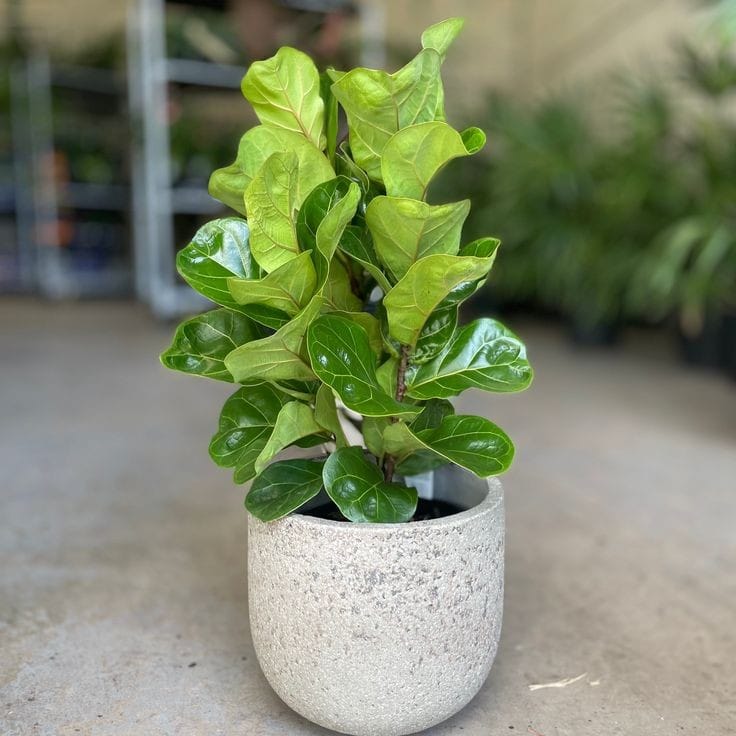
What are the different types of Fiddle Leaf Fig plant?
1.Variegated Fiddle Leaf Fig:-
These have leaves with variegation, meaning they display patterns of different colors, typically white or cream, alongside the usual green.
2. Compact Fiddle Leaf Fig:-
Some specimens have a more compact growth habit compared to others, making them suitable for smaller indoor spaces.
3. Bambino Fiddle Leaf Fig:-
This is a dwarf variety of Ficus lyrata, characterized by smaller leaves and a more diminutive overall size, making it ideal for tabletops or small spaces.
4. Fiddle Leaf Fig 'Suncoast':-
This variety is known for its ability to tolerate slightly lower light conditions compared to the standard Fiddle Leaf Fig, making it more adaptable to indoor environments with less natural light.

How to care for Fiddle Leaf Fig
1.Location:
Fiddle Leaf Fig plant that provides bright, indirect sunlight. Avoid placing it in direct sunlight, as this can scorch the leaves. Ideally, position the plant near a north or east-facing window where it can receive plenty of natural light without direct exposure to the sun's rays. Additionally, ensure the room maintains a consistent temperature between 60-75°F (15-24°C) to promote healthy growth. By selecting an appropriate location with the right lighting conditions, you can help your Fiddle Leaf Fig thrive and flourish.
2.Sunshine:
Fiddle Leaf Fig plants thrive in bright, indirect sunlight. This means placing them near a window where they can receive plenty of natural light without direct exposure to the sun's harsh rays. Direct sunlight can scorch the leaves of the plant, leading to damage. Aim for a location with filtered or indirect sunlight, such as near a north or east-facing window, to provide the optimal amount of light for your Fiddle Leaf Fig to grow healthy and vibrant.
3.Soil:
For a Fiddle Leaf Fig plant, it's essential to use well-draining soil to prevent waterlogging, which can lead to root rot. A good soil mix for Fiddle Leaf Figs is a blend of peat moss, perlite, and pine bark or coconut coir. This mixture provides adequate aeration and drainage while retaining some moisture to keep the plant hydrated. Avoid heavy soils or those prone to compacting, as they can suffocate the roots. Using a high-quality, well-draining soil will help your Fiddle Leaf Fig thrive by ensuring proper root health and nutrient uptake.
4.Hydration:
Proper hydration for a Fiddle Leaf Fig plant involves watering it when the top inch of soil feels dry to the touch. Allow the soil to dry out slightly between waterings to prevent overwatering, which can lead to root rot. When watering, thoroughly saturate the soil until water drains from the bottom of the pot, ensuring thorough hydration. However, avoid leaving the plant sitting in standing water, as this can also cause root rot.

5.Nourishment:
Nourishing a Fiddle Leaf Fig plant involves providing it with balanced nutrients through fertilization. Use a liquid fertilizer specifically formulated for indoor plants, diluted to half strength, and apply it once a month during the growing season (spring and summer). Fertilizing helps replenish essential nutrients in the soil, promoting healthy foliage growth and overall plant vigor. However, avoid over-fertilizing, as this can cause fertilizer burn or salt buildup in the soil. By providing proper nourishment through regular fertilization, you can support the optimal health and growth of your Fiddle Leaf Fig plant.
6.Issues:
Common issues with Fiddle Leaf Fig plants include:
Overwatering
Under watering
Poor Drainage
Low Humidity
Pests
Improper Light
Nutrient Deficiency
What are the benefits of the Fiddle Leaf Fig plant?
The Fiddle Leaf Fig plant offers several benefits:
Air Purification
Aesthetic Appeal
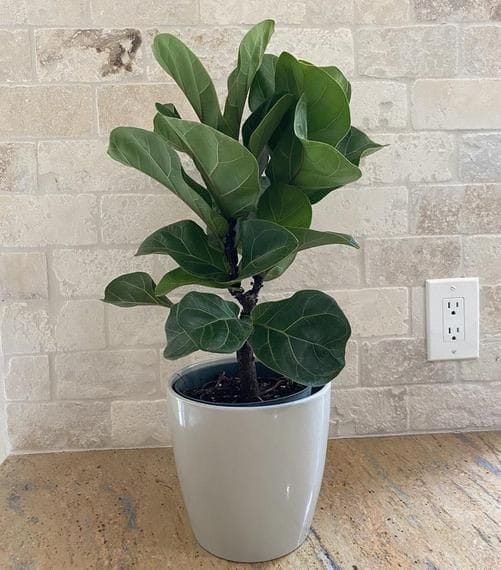
FAQS about growing Fiddle Leaf Fig plant
1.What are the optimal light conditions for a Fiddle Leaf Fig plant?
The optimal light conditions for a Fiddle Leaf Fig plant involve bright, indirect sunlight. Place the plant near a window where it can receive plenty of natural light without direct exposure to the sun's harsh rays. North or east-facing windows are ideal as they provide filtered light throughout the day. Avoid placing the plant in direct sunlight, as this can lead to sunburn and damage the leaves. Adequate light is essential for the Fiddle Leaf Fig's growth and overall health, but it's crucial to strike a balance to prevent leaf burn or stress.
2.How can I prevent common issues like root rot or leaf drop in my Fiddle Leaf Fig?
To prevent common issues like root rot or leaf drop in your Fiddle Leaf Fig, follow these guidelines: Allow the top inch of soil to dry out before watering. Avoid overwatering, as soggy soil can lead to root rot. Ensure proper drainage by using a well-draining soil mix and a pot with drainage holes. Use a pot with drainage holes to prevent water from pooling at the bottom, which can lead to root rot. Ensure excess water can escape freely. Adequate Lighting: Place your Fiddle Leaf Fig in bright, indirect sunlight. Avoid direct sunlight, as it can scorch the leaves and cause stress to the plant.Fiddle Leaf Figs prefer humid environments. Increase humidity by misting the leaves occasionally or placing a tray of water near the plant. This helps prevent dry, brown leaf edges. Ensure good air circulation around the plant to prevent stagnant air, which can promote fungal growth and other issues.
3.Are there any specific temperature or humidity requirements for Fiddle Leaf Figs?
Fiddle Leaf Figs thrive in temperatures between 60-75°F (15-24°C). They prefer consistent temperatures and are sensitive to cold drafts or sudden temperature fluctuations. Avoid placing them near air conditioning vents, heaters, or drafty windows. Fiddle Leaf Figs prefer moderately humid environments. Indoor humidity levels of around 50-60% are ideal. You can increase humidity by misting the leaves regularly, placing a tray of water near the plant, or using a humidifier. Adequate humidity helps prevent issues like dry, brown leaf edges and promotes healthy foliage growth. Maintaining suitable temperature and humidity levels is essential for the overall health and well-being of your Fiddle Leaf Fig plant.
4.What are some signs of pests or diseases that I should watch out for?
Look for tiny webs or speckled leaves. Spider mites are tiny arachnids that suck sap from the plant, causing stippling or yellowing of leaves. Check for white, cottony masses along stems or in leaf axils. Mealybugs feed on plant sap and can cause wilting, yellowing, or distorted growth. Look for small, raised bumps on stems or leaves. Scales feed on plant sap and can cause yellowing, wilting, or stunted growth.Watch for signs of fungal diseases such as leaf spots, moldy growth on leaves or soil, or wilting. Overwatering or high humidity can promote fungal infections. Check for mushy, brown roots or foul-smelling soil. Root rot is caused by overwatering or poor drainage and can lead to wilting, yellowing leaves, or plant death.
5. How often should I fertilize my Fiddle Leaf Fig, and what type of fertilizer should I use?
For Fiddle Leaf Fig plants, it's generally recommended to fertilize them once a month during the growing season, which typically spans from spring through summer. You can use a balanced liquid fertilizer specifically formulated for indoor plants. Dilute the fertilizer to half strength to avoid over-fertilizing, which can lead to salt buildup in the soil and harm the plant. Apply the diluted fertilizer to the soil around the base of the plant, following the instructions on the fertilizer packaging for proper application.
